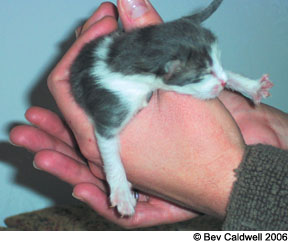Some cats arrive at shelters ready for placement in new homes. For others, adoption may be an unlikely destination at the end of a rocky road. Illness, physical handicaps, recovery from surgery, behavior problems or the lack of socialization can bar their way. Many cats and kittens would have little hope of a new life without the tireless efforts of foster volunteers. Fostering is an extremely needed resource for shelters, says Andy Newmark, DVM, chief veterinarian for the Humane Society at Lollypop Farm, a shelter in Fairport, New York.
Beneficial All the Way Around
Foster parents provide cats and kittens with a hopeful future by taking them into their homes on a temporary basis and socializing or rehabilitating them. Foster volunteers can afford shelters some breathing room when the shelters would otherwise be bursting at the seams. Lollypop Farm took in 9,000 cats last year, and of those, 1,200 needed to be fostered. If I didnt have that resource, many cats would never have survived, says Dr. Newmark.

288
Like many shelters that accept any animal at any time, Lollypop Farm has no room to house the influx of kittens or older cats while they are convalescing. Of those 1,200 cats that needed to be fostered through Lollypop Farm, about 900 were kittens. Young ones are more susceptible to respiratory infections the longer they stay in a shelter, says Dr. Newmark.
For prospective pet parents, finding a cat thats good to go enables them to spend those first few weeks getting to know their new companion rather than potentially making repeated trips to a veterinarian for vaccinations, battling fleas or dealing with other health problems. Animals entering the foster program at Lollypop Farm are spayed or neutered if old enough, tested for contagious diseases, treated for intestinal parasites and given flea treatments and vaccinations. Once the animal is rehabilitated or socialized, it is put up for adoption. The cost for the basic medical care is included in the adoption fee, says Dr. Newmark.
Adopting a cat with no record of its past can be a bit daunting for adopters, especially if they have never had a cat before. The Cat Adoption Team (CAT) in Sherwood, Oregon, requires foster volunteers to maintain detailed, dated medical records that can then be shared with adopters, giving them a history of their cats health so they know what the cat has experienced and what they as pet parents might face.
Lending a Hand
People who want to become foster volunteers should contact animal organizations in their area. Some groups that dont have a physical building in which to house animals rely solely on foster homes in which to place animals until permanent homes can be found. Volunteers must go through orientation and training and abide by the regulations of the organization for which they function. Rules vary from place to place.
The Cat Adoption Team requires prospective volunteers to attend an orientation session and provides a packet that includes program guidelines. The volunteer must also sign a contract that stipulates that they must keep cats indoors and not expose them to outdoor cats, follow CAT instructions for medical care and keep a detailed log of medical information.
The volunteer is then paired with a mentor – a volunteer with experience handling typical fostering situations such as pregnancy and birth who keeps in contact with the foster family and can provide referrals to other information sources. Our mentor program has been very successful, says Kristi Brooks, who has fostered more than 40 cats in her home and now manages the foster program for the Cat Adoption Team. It helps foster parents get in touch with someone right away and obtain instant answers to questions and resources.
Becoming a foster volunteer is a rewarding experience. Of course, spending so much time with a foster cat can lead to attachment. Each organization has its own rules about allowing foster volunteers to adopt their feline wards. If a volunteer wants to adopt a foster cat, we still have to go through the adoption process, says Dr. Newmark.
Handling Behavior Problems
Volunteers, however, should be aware that not all situations turn out well. Sometimes a cat has behavior problems that cant be corrected with existing shelter or program resources or a medical condition that cant be fixed. Some animals have health problems and wont recover, says Dr. Newmark, and sometimes tough decisions like euthanasia have to be made.
Many of the candidates for fostering are kittens, some very young or left without a mother before they were weaned. Not all kittens will thrive. More often than not, you will have a litter with no problems, says Brooks, but there is always the chance that disaster can happen.
To help volunteers who are fostering kittens, CAT provides medical baby bags filled with supplies to reduce middle-of-the-night trips to the grocery store or the emergency room. CAT also has vaccine coordinators who come to the foster home so the cat does not have to come to the shelter until it is ready for adoption.
Foster volunteers must also take care if they have other cats at home. Make certain resident cats are current on vaccinations and practice good hygiene. We suggest they keep the foster cat separate, sayd Dr. Newmark, because some diseases are transmissable.
Volunteers should socialize and spend time with the foster cats as well as learn the signs of problems. Have fun with the cats, says Dr. Newmark, and dont blame yourself if something goes wrong.



